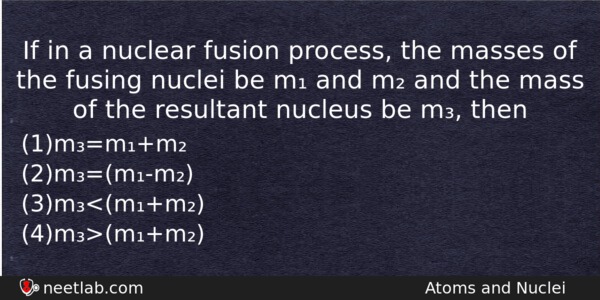| ⇦ | 
| ⇨ |
If in a nuclear fusion process, the masses of the fusing nuclei be m₁ and m₂ and the mass of the resultant nucleus be m₃, then
Options
(a) m₃=m₁+m₂
(b) m₃=(m₁-m₂)
(c) m₃<(m₁+m₂)
(d) m₃>(m₁+m₂)
Correct Answer:
m₃<(m₁+m₂)
Explanation:
(m₁+m₂) = m₃ + binding energy equivalent to mass
⇒ (m₁+m₂) > m₃
⇒ m₃<(m₁+m₂)
Related Questions: - Two tuning forks are sounded together and produce 2 beats per second.
- During production of cathode ray
- A lead bullet of 10 gm travelling at 300 m/s strikes against a block
- Consider two particles of different masses. In which of the following situations
- A closely wound solenoid of 2000 turns and area of cross-section 1.5 x 10⁻⁴ m² carries
Topics: Atoms and Nuclei
(136)
Subject: Physics
(2479)
Important MCQs Based on Medical Entrance Examinations To Improve Your NEET Score
- Two tuning forks are sounded together and produce 2 beats per second.
- During production of cathode ray
- A lead bullet of 10 gm travelling at 300 m/s strikes against a block
- Consider two particles of different masses. In which of the following situations
- A closely wound solenoid of 2000 turns and area of cross-section 1.5 x 10⁻⁴ m² carries
Topics: Atoms and Nuclei (136)
Subject: Physics (2479)
Important MCQs Based on Medical Entrance Examinations To Improve Your NEET Score
18000+ students are using NEETLab to improve their score. What about you?
Solve Previous Year MCQs, Mock Tests, Topicwise Practice Tests, Identify Weak Topics, Formula Flash cards and much more is available in NEETLab Android App to improve your NEET score.
Share this page with your friends

Leave a Reply